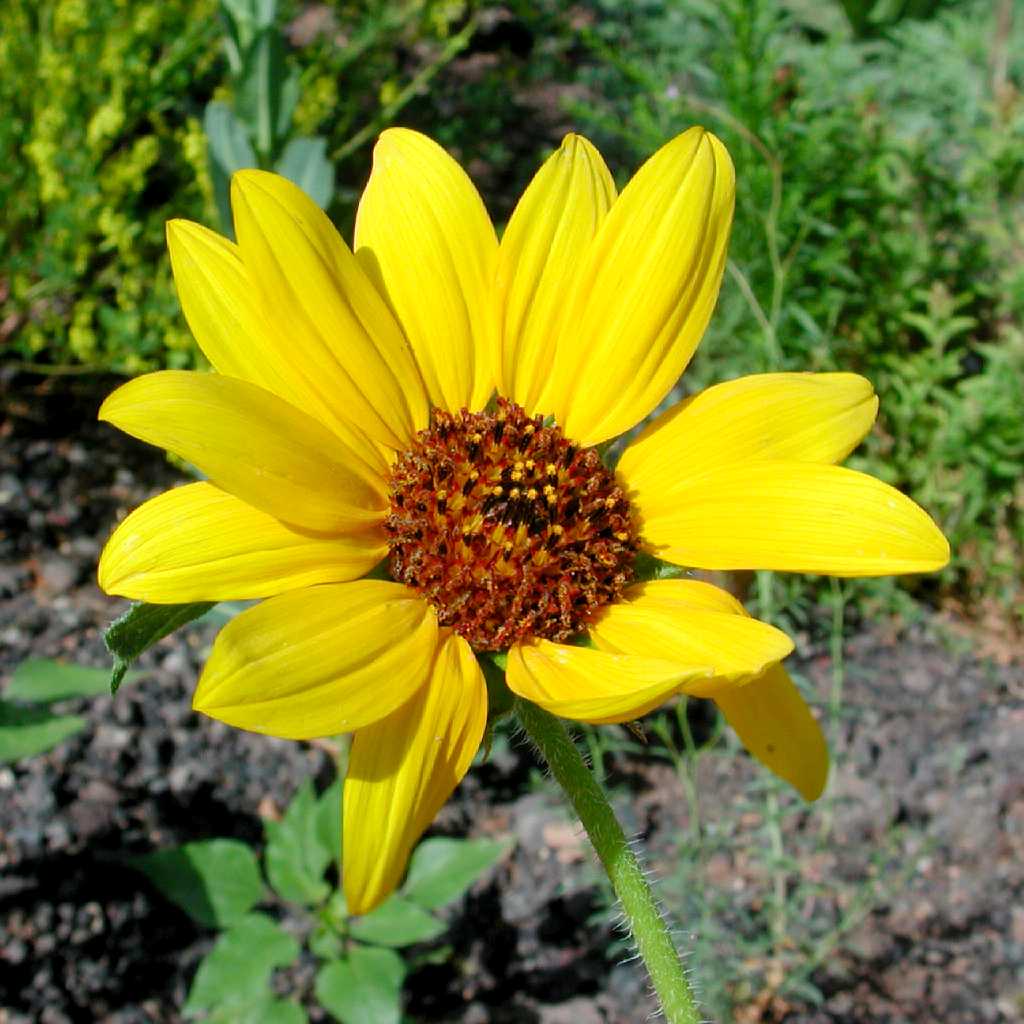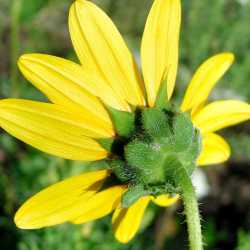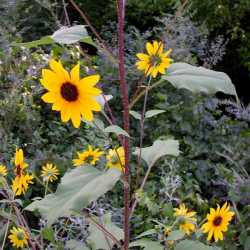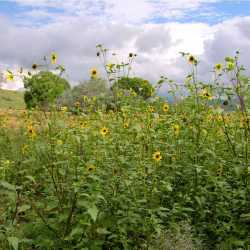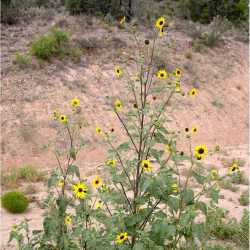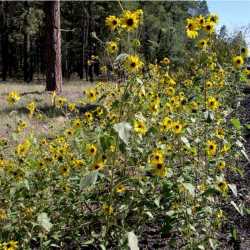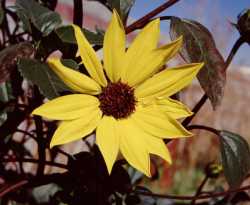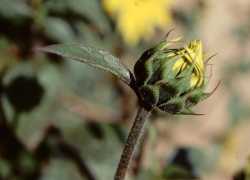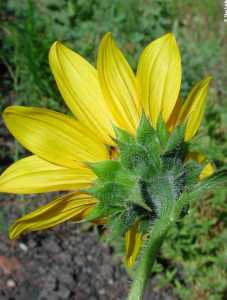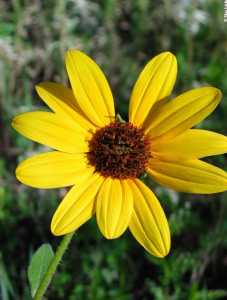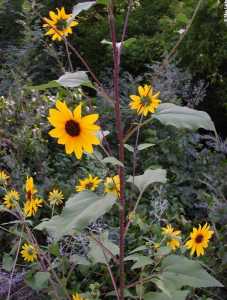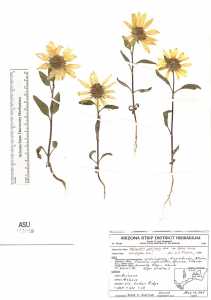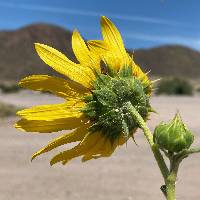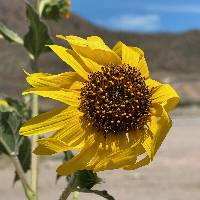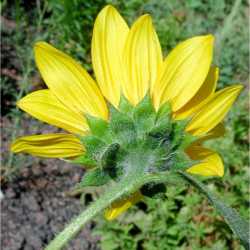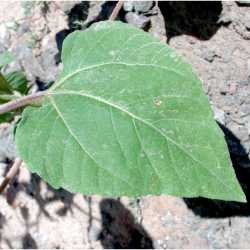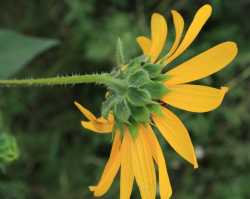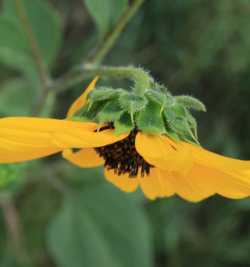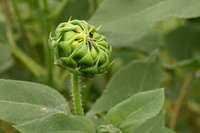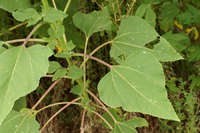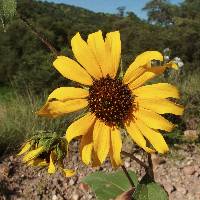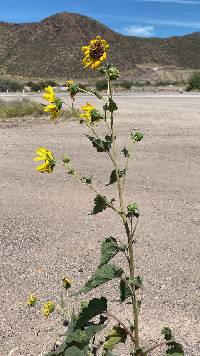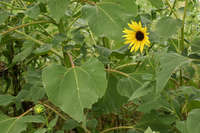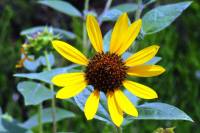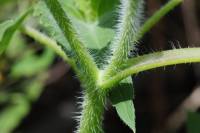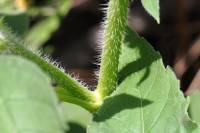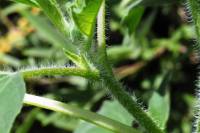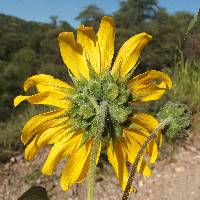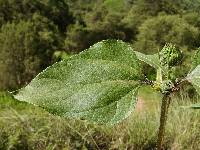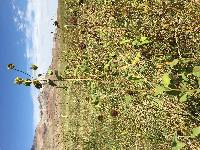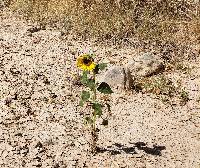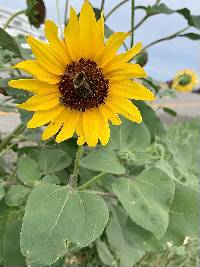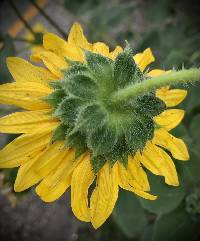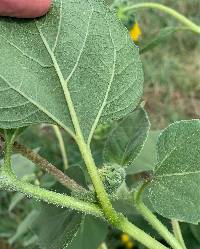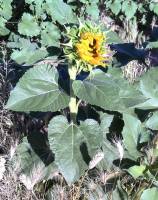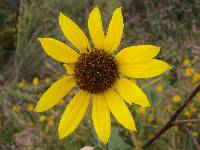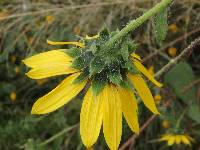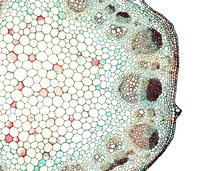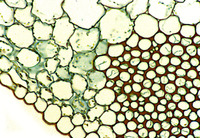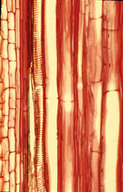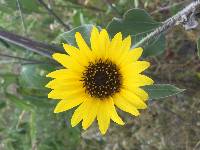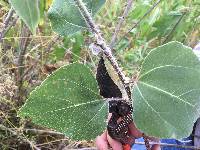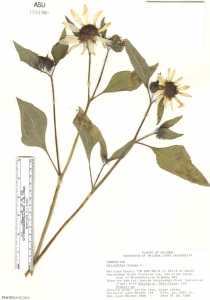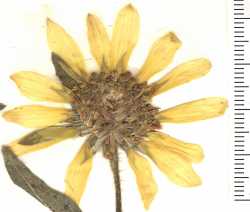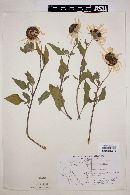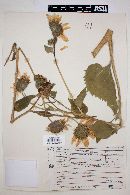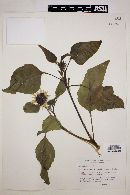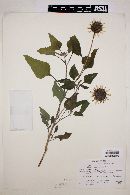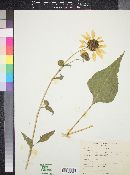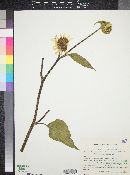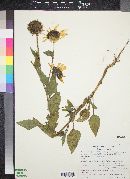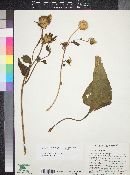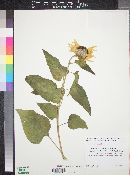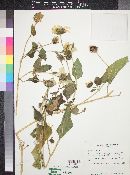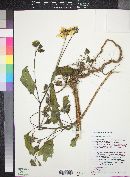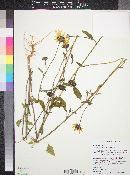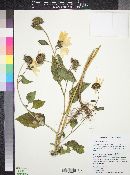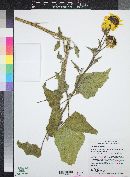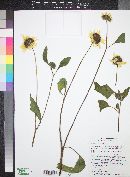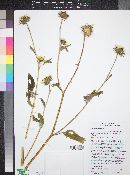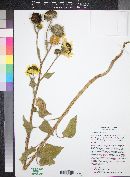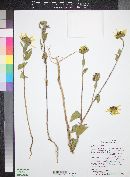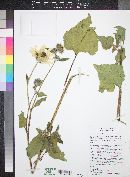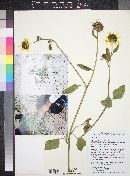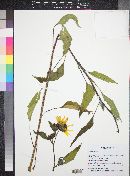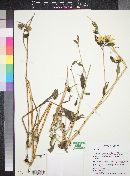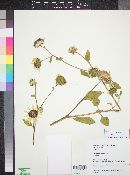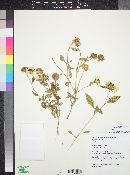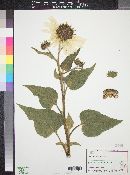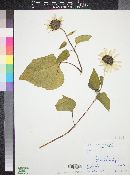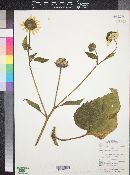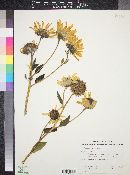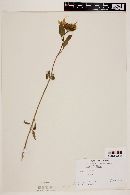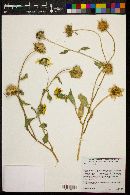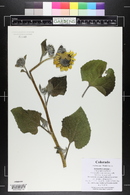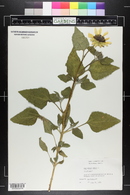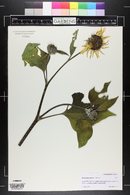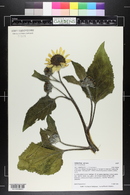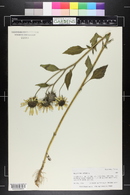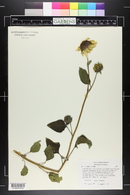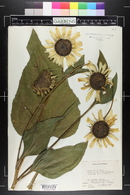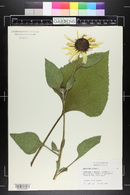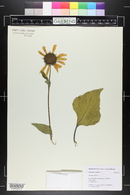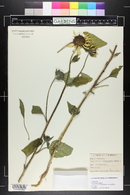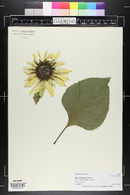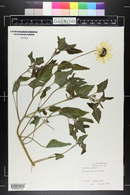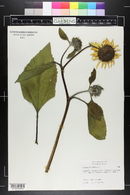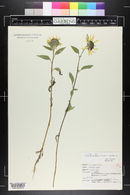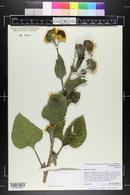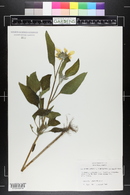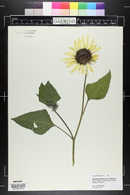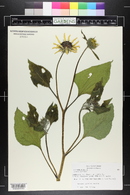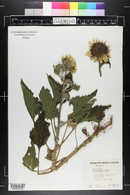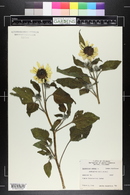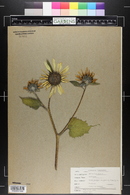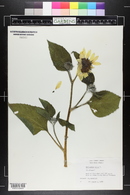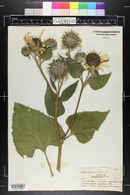
|
|
|
|
Family: Asteraceae
Common Sunflower, more...Hopi sunflower, annual sunflower, sunflower, wild sunflower (es: girasol, mirasol, flor de sol)
[Helianthus annuus subsp. jaegeri (Heiser) Heiser, moreHelianthus annuus subsp. lenticularis (Dougl. ex Lindl.) Cockerell, Helianthus annuus subsp. texanus Heiser, Helianthus annuus var. lenticularis (Dougl. ex Lindl.) Steyermark, Helianthus annuus var. macrocarpus (DC.) Cockerell, Helianthus annuus var. texanus (Heiser) Shinners, Helianthus aridus Rydb., Helianthus jaegeri Heiser, Helianthus lenticularis Douglas ex Lindl.] |
Annuals, 100-300 cm. Stems erect, usually hispid. Leaves mostly cauline; mostly alternate; petioles 2-20 cm; blades lance-ovate to ovate, 10-40 × 5-40 cm, bases cuneate to subcordate or cordate, margins serrate, abaxial faces usually ± hispid, sometimes gland-dotted . Heads 1-9. Peduncles 2-20 cm. Involucres hemispheric or broader, 15-40(-200+) mm diam. Phyllaries 20-30(-100+), ovate to lance-ovate, 13-25 × (3-)5-8 mm, (margins usually ciliate) apices abruptly narrowed, long-acuminate, abaxial faces usually hirsute to hispid, rarely glabrate or glabrous, usually gland-dotted. Paleae 9-11 mm, 3-toothed (middle teeth long-acuminate, glabrous or hispid). Ray florets (13-)17-30(-100+); laminae 25-50 mm. Disc florets 150+(-1000+); corollas 5-8 mm (throats ± bulbous at bases), lobes usually reddish, sometimes yellow ; anthers brownish to black, appendages yellow or dark (style branches yellow) . Cypselae (3-)4-5(-15) mm, glabrate ; pappi of 2 lanceolate scales 2-3.5 mm plus 0-4 obtuse scales 0.5-1 mm. 2n = 34. Flowering summer-fall. Open areas; 0-3000 m; St. Pierre and Miquelon; Alta., B.C., Man., N.B., N.W.T., N.S., Ont ., P.E.I., Que., Sask.; Ala., Ariz., Ark., Calif., Colo., Conn., Del., D.C., Fla., Ga., Idaho, Ill., Ind., Iowa, Kans., Ky., La., Maine, Md., Mass., Mich., Minn., Miss., Mo., Mont., Nebr., Nev., N.H., N.J., N.Mex., N.Y., N.C., N.Dak., Ohio, Okla., Oreg., Pa., R.I., S.C., S.Dak., Tenn., Tex., Utah, Vt., Va., Wash., W.Va., Wis., Wyo.; Mexico; intoduced nearly worldwide. Helianthus annuus is widely distributed, including weedy, cultivated, and escaped plants. It is the only native North American species to become a major agronomic crop. Despite its considerable variability, attempts have failed to produce a widely adopted infraspecific system of classification. Forms with red-colored ray laminae, known from cultivation and occasionally seen escaped, trace their ancestry to a single original mutant plant. It hybridizes with many of the other annual species.
FNA 2006, Wiggins 1964, Kearney and Peebles 1969, Heil et al 2013, FNA 2006 Duration: Annual Nativity: Native Lifeform: Forb/Herb General: Stout annual herbs, 30 cm to 2 m tall or more; stems erect, rough-hairy. Leaves: Only the lowermost leaves opposite, otherwise alternate; long-petioled; blades ovate or even broader, especially the lower leaves, 4-20 cm long by 3-15 cm wide, the edges coarsely toothed to (less commonly) almost entire; surfaces rough-hairy. Flowers: Flower heads large, showy and radiate, yellow with brown centers, solitary or few at the ends of stems and branches; involucres broadly hemispheric, the disc generally 2-4 cm wide (more so in cultivated specimens), the bracts (phyllaries) ovate with a long narrow tip, more-or-less pubescent and ciliate-margined; ray florets 10-30 per flower head (more in cultivated specimens), yellow, the laminae (ray petals) 15-40 mm long; disc florets 100 or more per flower head, purplish-brown or occasionally yellow; central receptacle bracts (paleae) inconspicuously pubescent at the tips and more or less the same as the marginal paleae. Fruits: Achenes plump, 4-5 mm long or more when cultivated, glabrous or finely pubescent; topped with a pappus of 2 or more awns or scales. Ecology: Found in open or disturbed areas such as roadsides and floodplains, from 1,000-7,000 ft (305-2134 m); flowers March-October. Distribution: Cosmopolitan, on every continent, throughout N. America and in every state in the US; south through MEX to S. Amer. Notes: This species is native to North America and has a long history of cultivation, originally by native Americans for its edible seed. It is said to be the only North American plant to become a major agronomic crop, now cultivated worldwide for edible seeds and oil production. A related native species, H. petiolaris, is very similar but smaller and more slender in all respects, with phyllaries lanceolate and usually not ciliate-margined, and the central receptacle scales conspicuously white-bearded at the tip. Helianthus specimens can be difficult to assign to species, especially since hybridization sometimes occurrs, including backcrossing between wild and cultivated individuals. Host plant for California Patch, Bordered Patch, and Painted Lady butterflies. Ethnobotany: Seed is dried, ground and mixed with water to make a coffee-like drink. It is also ground to make sunflower seed cakes or crushed and boiled to make oil. The oil relieves coughs. The pith of a sunflower stalk has also been burned and used as a wart remover. Stalks used as fuel, livestock fodder, poultry food, and silage. Stems used as source of commercial fiber. Fiber may be used in paper. Etymology: Helianthus is from the Greek helios, sun and anthos, flower; annuus means annual. Synonyms: Helenium aridus, H. lenticularis Editor: SBuckley 2010, FSCoburn 2015, AHazelton 2017 Coarse, rough-hairy annual (0.5-)1-3 m; lvs chiefly alternate (except the lowermost), mostly toothed, long-petiolate, ovate or broader, at least the lower cordate in well developed plants; heads large, the red-purple (yellow) disk seldom under 3 cm wide; invol bracts ovate or ovate-oblong and abruptly narrowed above the middle to the acuminate tip, ciliate and with some rather long coarse hairs on the back; receptacle flat or nearly so, its bracts inconspicuously hairy at the tip; 2n=34. A weed in disturbed sites, especially in moist, low ground, throughout the U.S. and adj. Can. and Mex. July-Sept. Typical wild plants are branched, with several or many heads. Cult. forms, which readily escape, have solitary (or few), often much larger heads. (H. lenticularis; H. aridus) Gleason, Henry A. & Cronquist, Arthur J. 1991. Manual of vascular plants of northeastern United States and adjacent Canada. lxxv + 910 pp. ©The New York Botanical Garden. All rights reserved. Used by permission. From Flora of Indiana (1940) by Charles C. Deam This species has been cultivated more or less for many years in all parts of the state and there are reports of its escape from all parts of the state. I doubt whether it is a native of the state although in 1922 I found it to be a common weed along a sandy roadside and in an adjoining sandy, fallow field about 2 miles northeast of Jacksonville, Vermillion County. The plants were comparatively small, mostly from four to six feet high. Phinney in 1883 reported it as common in the prairies in Delaware County but most authors report it as an escape. ...... Indiana Coefficient of Conservatism: C = null, non-native Wetland Indicator Status: FACU |
|
|
|
This project was made possible in part by the Institute of Museum and Library Services [MG-70-19-0057-19].
Powered by Symbiota

